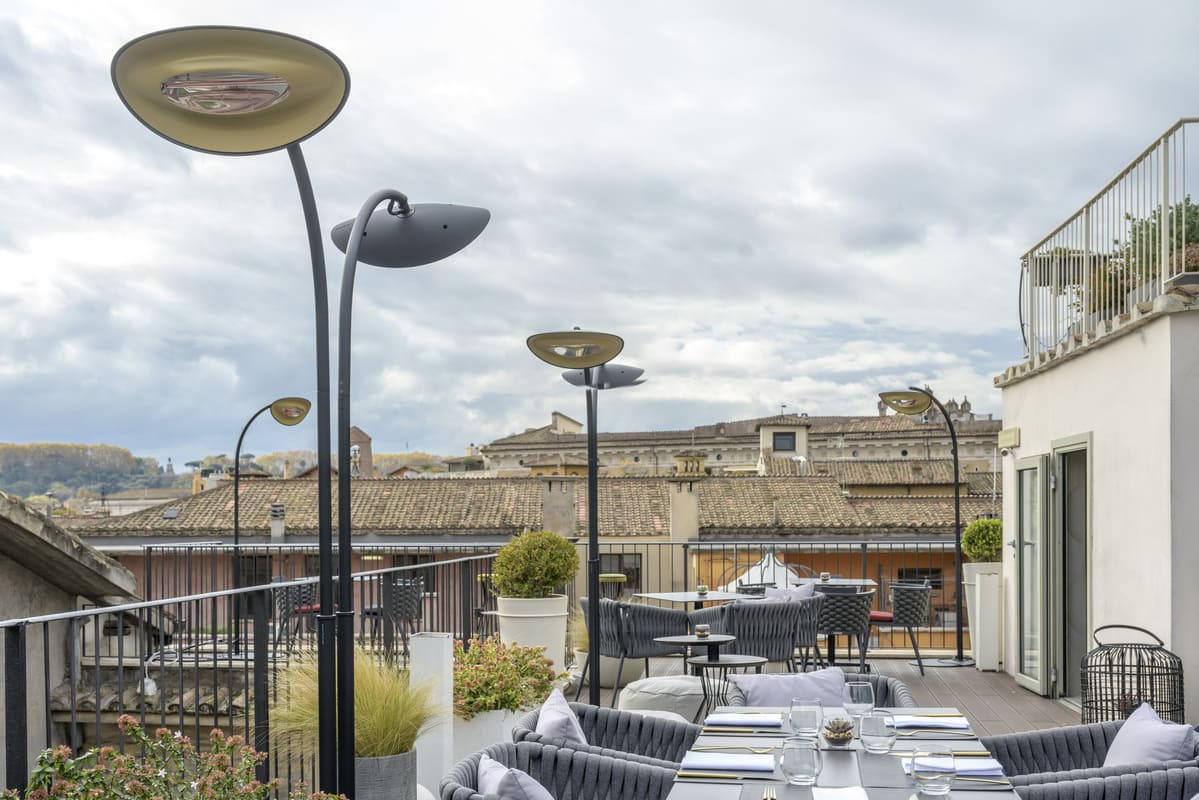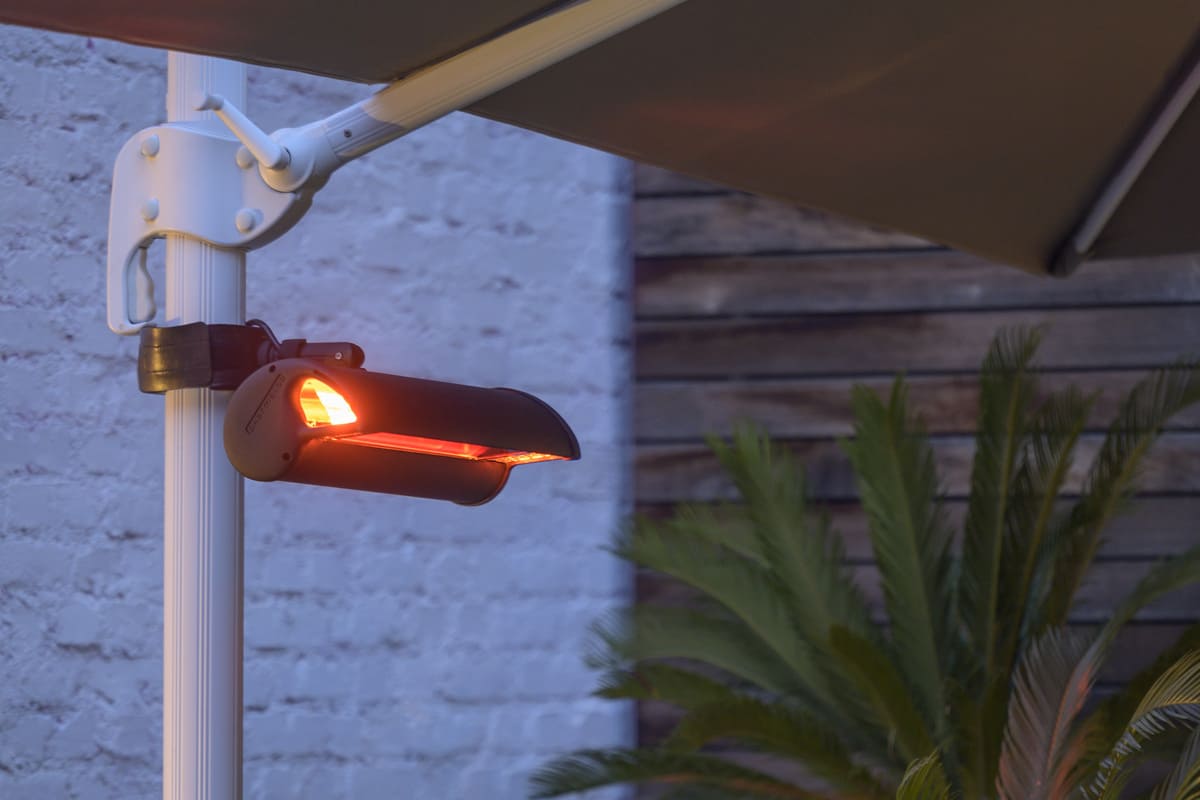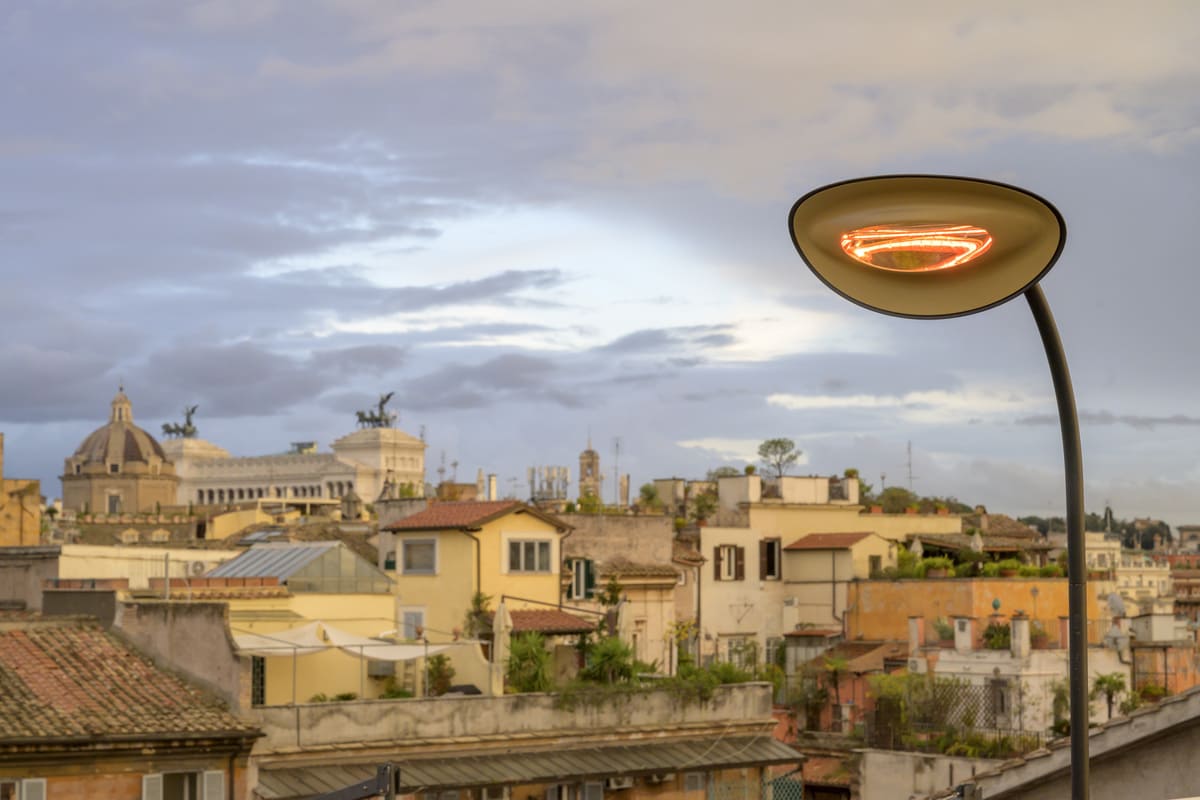With the arrival of colder weather, enjoying outdoor spaces can seem like a challenge. However,…

How to Heat Your Terrace with Infrared Lamps
Having a terrace is a great advantage, especially for those who love spending time outdoors. However, with the arrival of autumn or during cooler evenings, this space risks becoming unusable. The good news is that there’s a simple, effective, and aesthetically pleasing solution to continue enjoying your terrace even in the colder months: infrared lamps.
Increasingly popular in private homes, restaurants, bars, and hotels, infrared lamps represent a modern and functional heating system, perfect even for outdoor spaces such as terraces, balconies, verandas, and patios. Unlike traditional systems, which heat the surrounding air (easily dispersed outdoors), infrared technology acts directly on surfaces, people, and objects, providing an immediate and enveloping sensation of warmth, similar to that of the sun.
Moreover, infrared lamps stand out for their ease of installation, low energy consumption, and the ability to blend into any architectural setting, also thanks to the elegant and minimal design of the most modern models. Whether it’s a small city terrace or a large panoramic one, these solutions allow you to extend the use of your outdoor space in every season, enhancing comfort and quality of life.
In this article, we’ll discover the advantages of infrared lamps for terrace heating, how to choose the model that best suits your needs, and where to place it to achieve maximum effectiveness—without forgetting about aesthetics. Ready to enjoy your terrace all year round? Start here.
Why Choose Infrared Lamps to Heat Outdoor Spaces
Heating outdoor spaces can be a real challenge, especially during the colder months. Air disperses easily, traditional methods like gas heaters or patio heaters have high consumption, require constant maintenance, and are often bulky or not very aesthetic. In this context, infrared lamps present themselves as the ideal solution, capable of combining efficiency, practicality, and design.
The first advantage of infrared lamps is the type of heat they produce. Unlike systems that heat the air (ineffective outdoors), infrared lamps emit direct heat, which is absorbed by people, surfaces, and objects—just like the sun’s rays. This means that even in the presence of wind or in very open environments, you’ll feel a pleasant, immediate, and constant warmth.
Another reason to choose this technology is its energy efficiency. Infrared lamps consume less than traditional systems and, thanks to targeted heating, avoid unnecessary dispersion. Some models also allow you to adjust the intensity or program the operation, further optimizing energy use.
In addition, infrared lamps stand out for their versatility and ease of installation: they can be wall-mounted, ceiling-mounted, or come in free-standing versions, without the need for invasive work. All this with a modern and discreet aesthetic, perfect even for elegant spaces like terraces, patios, or verandas.
Choosing an infrared lamp for outdoor heating means improving the comfort of your outdoor space, extending the usable season, and creating a welcoming environment all year round—without sacrificing style.
How Infrared Heat Works
Infrared heat represents an innovative technology that is revolutionizing the way we heat spaces, especially outdoor ones such as terraces, balconies, or verandas. But how does it work exactly?
Unlike traditional heating systems, which warm the surrounding air, infrared lamps heat directly the surfaces, objects, and people present in the environment by emitting electromagnetic waves similar to those of the sun. It’s the same principle that makes us feel warm in the sun even on a cold day: it’s not the air that is warm, but our body absorbing solar energy.
This heating method is particularly effective in open or semi-open spaces, where the warm air generated by traditional systems quickly disperses. With infrared, heat is felt directly and immediately as soon as the lamp is switched on, without having to wait for all the air to warm up.
There are different types of infrared lamps, which vary based on the emitted wavelength: short, medium, or long waves. Short-wave lamps are best suited for outdoor spaces because they generate more intense heat and are more resistant to wind.
Moreover, the heat emitted is clean, silent, and free of harmful emissions, making this technology not only efficient but also environmentally sustainable. Some models even allow heat intensity adjustment, offering personalized control of thermal comfort.
In summary, infrared heat works in a direct, safe, and immediate way, and is ideal for those who want to heat their terrace without dispersion, maintaining a welcoming and functional environment in every season.
Where to Place Infrared Lamps for Optimal Heating
The correct placement of infrared lamps is fundamental to achieving effective and even heating of the terrace. Unlike traditional systems that warm the air, infrared lamps operate by direct radiation. So it is important to strategically orient them toward the areas where you want to feel the heat.
First, consider the main usage area. If you have a table with chairs, an outdoor lounge set, or a relaxation zone, the lamps should be positioned to cover these areas with a direct beam. It is advisable to install them high up, on walls or ceilings, with an inclination between 30 and 45 degrees downward, to spread the heat in a targeted way without dispersion.
In the case of open and unprotected terraces, it is useful to exploit more sheltered surfaces. Such as corners or side walls, to avoid wind or drafts reducing the heating’s effectiveness. If the terrace is covered, for example by a canopy or pergola, ceiling mounting is an ideal solution to discreetly heat large surfaces.
On very large terraces or those divided into multiple zones, multiple lamps can be installed to create independent comfort areas. In this case, it is better to choose adjustable models with intensity control to adapt the heat according to needs.
Finally, pay attention to the minimum safety distance indicated by the manufacturer: installing lamps too close to people or objects can reduce system safety and efficiency.
Good placement guarantees immediate heat, lasting comfort, and a terrace usable all year round, even during the coldest seasons.
Energy Consumption and Savings: How Much Does It Cost to Heat a Terrace with Infrared?
One of the main advantages of infrared lamps is energy efficiency, especially compared to other outdoor heating solutions such as gas heaters or patio heaters. But how much does it really cost to heat a terrace with this technology?
Infrared lamps run on electricity and typically consume between 1,000 and 2,500 watts per hour, depending on the power of the chosen model. For a practical example, a 1,500 W lamp used for 2 hours a day will have a monthly consumption of about 90 kWh. With the cost varying based on the electricity supply contract, but generally around 20 to 30 euros per month. This is a reasonable investment considering the possibility of using the terrace even during the colder months.
Unlike other systems, the heat generated by infrared is directional and immediate. So it’s not necessary to warm the entire environment. Just aim the lamp at the area to be used, thus reducing waste and dispersion. This makes infrared lamps a strategic choice also from a savings perspective.
Furthermore, many modern models offer power adjustment functions or presence sensors, which further optimize consumption. Some lamps can even be integrated with smart home systems to control them remotely and schedule activation only when needed.
In summary, heating a terrace with infrared is not only possible but also economically advantageous. With the right model choice and conscious use, it’s easy to find a balance between comfort and low costs.




 WhatsApp
WhatsApp